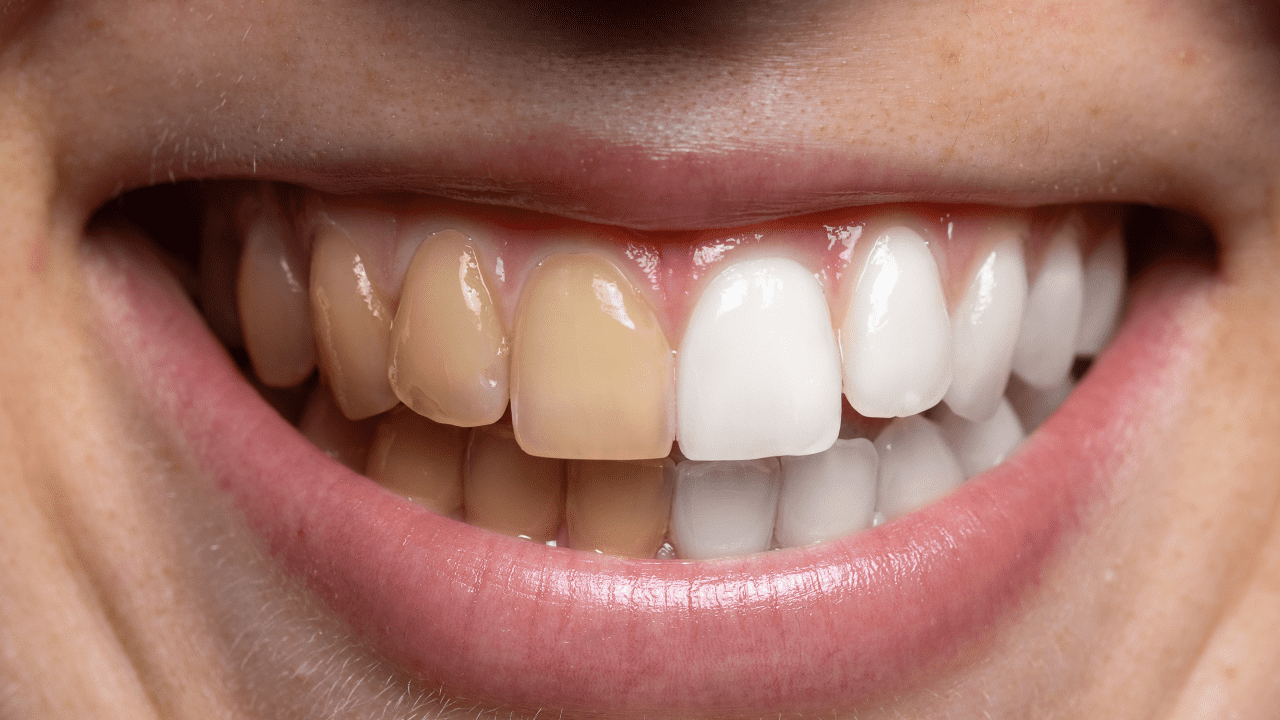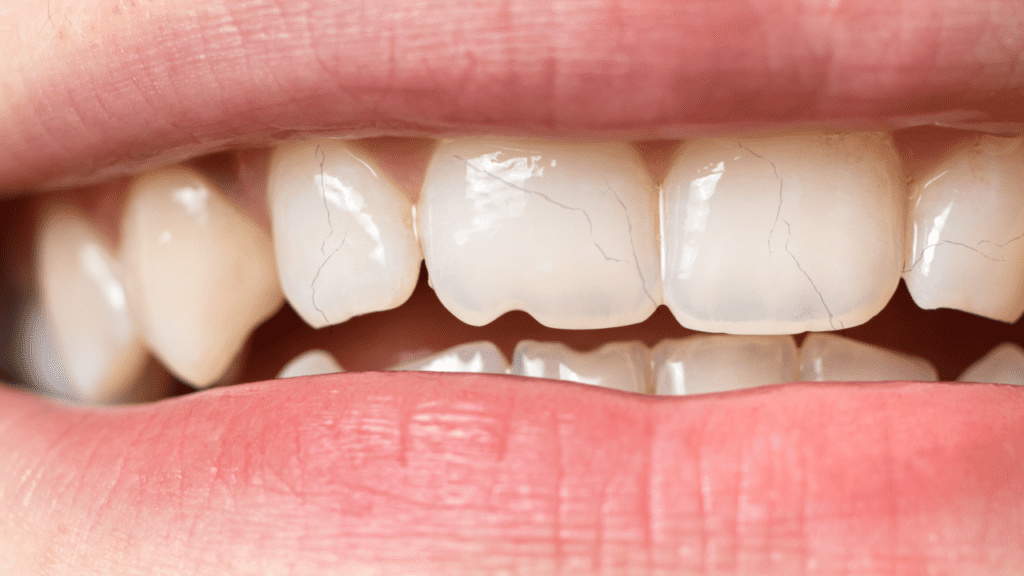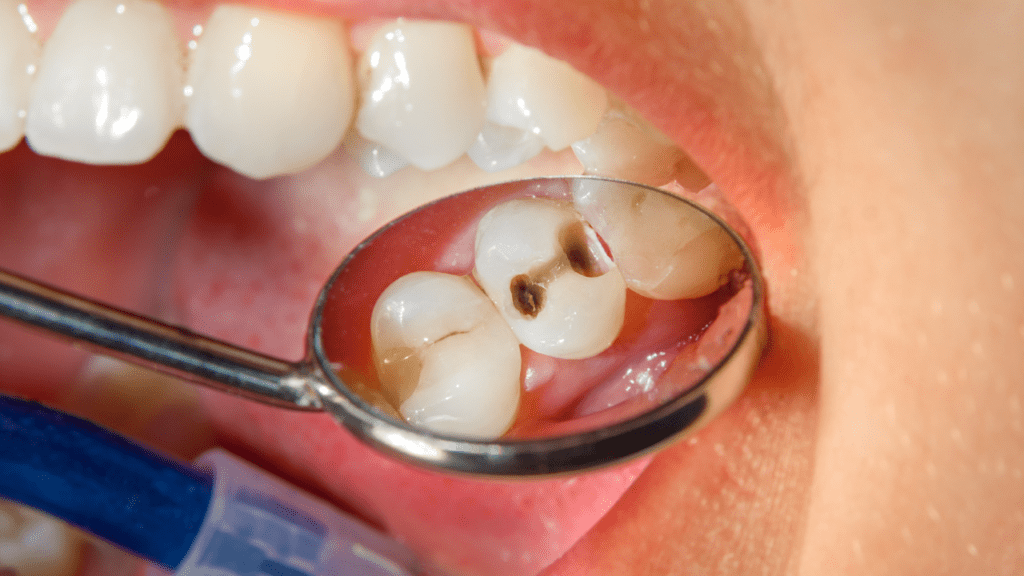So you noticed a dark spot on your teeth but aren’t sure if it’s a cavity or a tooth stain? Sometimes they can look very similar, but in this blog post, we will go over the differences, what to do if you have a cavity or a tooth stain, and tips to prevent stains and cavities in the first place. Let’s get started!
What is a cavity?
A cavity is a hole in your tooth that’s caused by decay. Decay happens when plaque and tartar build up on your teeth and break down your tooth’s enamel or outer layer. Plaque is a sticky film of bacteria that forms on your teeth, and tartar is hardened plaque. When Plaque builds up on the tooth, over time, it can cause a cavity to form due to the bacteria eating away at your teeth in that area.
Cavities can happen to anyone, but they’re more common in kids and teens because they may not brush their teeth as well as adults and frequently occur if you have a diet high in sugar. You’re also more likely to get cavities if you have a dry mouth, which means you don’t have enough saliva to wash away the bacteria in your mouth.
What color is a cavity?
Cavities appear in a range of colors depending on the stage of the cavity. They are usually a dark color, often brown or black, but may also appear yellow or orange. You may see them on your teeth if they are large enough. However, smaller cavities may not be visible to the naked eye and can only be detected through a dental X-ray.
What causes Cavities?
Bacteria cause cavities. When you eat, the bacteria in your mouth turn the sugars and carbohydrates in your food into acids. These acids attack tooth enamel, causing it to break down and form a cavity. The bacteria can also produce toxins that damage the gums and cause inflammation.
Failure to clean and floss your teeth properly
Brushing your teeth only cleans about 60% of your tooth surfaces. You must floss to clean the other 40%. If you don’t, food and bacteria will remain stuck between your teeth and gums, causing plaque to form. Tartar is much harder to remove than plaque and can only be removed by a dental professional. The plague and tartar then damage your tooth enamel, causing cavities.
Eating a lot of sugary snacks.
Snacking might not seem like a big deal, but the sugar in snacks can contribute to cavities. When you eat sugary snacks, the bacteria in your mouth produce acids that attack your tooth enamel. If you snack often, these acids can break down your enamel and cause a cavity.
It’s best to limit sugary snacks and brush your teeth after eating. You can also rinse your mouth with water after snacking to help remove any leftover sugar. Sugary drinks, like soda and juice, can also cause cavities. So it’s important to limit these drinks as well.
What is A Tooth Stain?
A tooth stain is a discoloration of the tooth that various things can cause. The discoloration can be on the surface of the tooth (called extrinsic stains), or it can be deeper within the tooth (called intrinsic stains).
What causes a stain?
Many factors can cause tooth stains. Here are the top reasons tooth stains form on the teeth.
Foods and drinks
Some of the biggest offenders when it comes to staining teeth are our daily consumption. Coffee, tea, red wine, and soda pop can all lead to discoloration of our teeth. Even healthy foods like blueberries and soy sauce can cause staining. Foods and beverages typically cause stains that are extrinsic and can be removed with a toothbrush or by getting a professional cleaning.
Tobacco products
It’s no secret that tobacco use is one of the leading causes of many health problems, including tooth stains. Both smoking and chewing tobacco can leave dark stains on your teeth.
Age
As we age, our teeth naturally begin to yellow. This is due to the wear and tear of everyday life and the loss of enamel on our teeth. Enamel is the outermost layer of our teeth, and it protects against staining.Since dentin is the darker, more yellow layer of the tooth, when enamel is lost, it leaves dentin exposed and gives your teeth a darker appearance.
Certain medications
Some medications, such as tetracycline antibiotics and certain antipsychotics, can cause tooth discoloration. If you are taking any medication, ask your doctor or dentist if it may lead to stains on your teeth.
Poor oral hygiene
You will likely develop tooth stains if you don’t brush and floss your teeth regularly. Remove the plaque and tartar from your teeth daily to prevent staining.
How To Tell If it’s A Cavity Or A Stain
Stains affect several teeth.
Stains can discolor several teeth at once and are generally easier to spot than cavities. A cavity may affect one tooth and is often not as noticeable. The cavity spot may also be darker than the rest of the tooth.
Cavities may cause other problems.
There are other problems that may arise from cavities. Your teeth may become more sensitive to hot and cold temperatures. You may also notice that your teeth look different. They may have a hole in them. Pain is also a common symptom of cavities. Stains, on the other hand, are usually not harmful. They’re just cosmetic issues.
Can A Stain Look Like A Cavity?
Yes, a stain can look like a cavity. Many people mistake stains for cavities all the time. The two main reasons for this are that stains can be dark or uneven in color, and Cavities typically form in areas where there is already tooth decay.
What Should You Do If you Notice A Cavity Or Stain?
A cavity or tooth stain can be unsightly, and it’s essential to take care of them as soon as possible. If you’re unsure what to do, here are a few tips.
How To Treat Tooth Stains
First, try to brush the affected area gently with a toothbrush. If the stain is still there, you can try using whitening toothpaste. You can also try using a mouthwash that contains hydrogen peroxide.
If the stain is deeper than just the surface of your teeth, Here are some things you can do.
Teeth Whitening Strips
Teeth whitening strips are one of the simplest ways to whiten your teeth at home. Teeth whitening strips are perfect for those with tooth sensitivity because while it does feature more hydrogen peroxide than what you would find in toothpaste, it doesn’t have enough to cause severe tooth sensitivity.
At-Home Teeth Whitening Kit
An at-home teeth whitening kit is also a great option. Whitening kits have more hydrogen peroxide than what you would find in strips, so you might experience some tooth sensitivity. But if you have some stains that won’t seem to go away, this could be the perfect option.
Professional Stain Removal By A Dentist
If you have tried everything and your stains won’t seem to go away, then you will have to go to the dentist. Dentists have professional teeth whitening tools and can use a higher potency of hydrogen peroxide formulas that aren’t allowed to be sold in at-home kits.
How To Treat Cavities
If you have a cavity, you must visit your dentist for treatment. Here are the three professional treatments performed by dentists depending on the severity of the cavity.
Fillings
Fillings are used to restore or replace a tooth’s natural structure. There are different types of fillings, each with its benefits. The filling you get will be based on the location and size of the cavity and your personal preference.
The most common fillings are made from composite resin, porcelain, or amalgam silver. Composite resin is a mixture of plastic and fine glass particles. It can be matched to the color of your natural teeth and is less visible than other fillings. Porcelain is also matched to the color of your teeth and is durable. Silver Fillings are also durable but more visible than other fillings.
Crown treatment
Crown treatments are used to address a number of dental concerns, including cavities, stains, and misshapen or damaged teeth. Crowns can be made from a variety of materials, including porcelain, ceramic, or composite resin. Each type of crown has its own advantages and disadvantages, so it’s important to discuss your options with your dentist before deciding on a treatment plan.
Root canals
A root canal is the best treatment for severe cavities.. It can help you avoid tooth loss and keep your smile healthy and bright.
A root canal is effective in treating cavities to help avoid tooth loss and keep your smile healthy and bright. The treatment involves removing the infected or damaged tissue from your tooth and then sealing it to protect it from further damage. A root canal is usually performed by a dentist or an endodontist, a specialist in treating problems with the pulp or nerve of the tooth.
How Can I Prevent Cavities?
Brush after eating
The most important time to brush your teeth is after you eat. Anytime you consume food or drink, bacteria in your mouth go to work, breaking it down into acids. These acids can wear away at tooth enamel, leading to cavities. Brushing helps remove food and bacteria from your teeth, lessening the chance of developing cavities. It’s best to brush within 30 minutes of eating.
If you can’t brush right after eating, try to at least rinse your mouth out with water. This will help remove some food and bacteria from your teeth and reduce the risk of cavities.
In addition to brushing, you should also floss your teeth once daily. This helps remove food particles and plaque from between your teeth, which your toothbrush may not reach.
Use mouthwash
Mouthwash can also help to reduce the risk of cavities by killing bacteria and freshening your breath. Be sure to choose a mouthwash that contains fluoride, as this will help to strengthen your teeth and prevent decay.
Limit sugary foods and drinks
As mentioned earlier, sugary foods and drinks majorly cause cavities. Therefore, it’s essential to limit your intake of these items. You don’t need to eliminate them, but enjoying them in moderation is best. If you do eat or drink sugary foods and drinks, make sure to brush your teeth afterward. This will help remove the sugar from your teeth and reduce your risk of cavities.
In addition to sugary foods and drinks, acidic foods and drinks can cause cavities. Therefore, limiting your intake of these items is also important. Some examples of acidic foods and drinks include citrus fruits, sports drinks, and soda.
Visit your dentist regularly.
One of the best ways to prevent cavities is to visit your dentist regularly. Your dentist can help keep your teeth and gums healthy and identify any potential problems early on. The earlier you catch a problem, the easier it is to treat it.
The dentist can also give you professional cleanings that remove plaque and tartar from your teeth, places that your toothbrush can’t reach. These cleanings can help prevent cavities, as well as gum disease.
How Can I Prevent Tooth Stains?
Brush Your Teeth Regularly
Cleaning your teeth properly is one of the best ways to prevent tooth stains. Use teeth-whitening toothpaste to help remove surface stains.
Avoid foods and drinks that cause stains.
Cut down on coffee, tea, red wine, and cola. They can all cause tooth stains over time.
Use a straw when you drink beverages that might cause staining. Sipping drinks through a straw helps to reduce the contact between your teeth and the staining liquid.
Stay away from tobacco.
Whether smoked or chewed, tobacco is one of the biggest contributors to tooth staining. If you can’t give it up entirely, reduce and brush your teeth immediately after using tobacco products.
Conclusion
Cavities and tooth stains can be unsightly and embarrassing. But with proper care and treatment, you can keep your teeth healthy and looking their best. Be sure to brush and floss regularly, visit your dentist for regular checkups, and avoid foods and drinks that can cause staining. And if you do develop a cavity or stains, don’t hesitate to seek professional treatment. Prevention is always the best medicine, but it’s never too late to take care of your teeth.
Related Articles
Small Cavities: Everything You Need To Know + Treatment
Marcus Ramsey has been a professional writer for over seven years. He has talked about and produced content for industries like Dentistry, Healthcare, and more.
Erica Anand is a certified dental expert. She holds a BA in Chemistry and a Doctorate of Dental Surgery from Stony Brook University. After completing a two-year pediatric dentistry program, she now runs a private practice focusing on preventive dentistry and is a member of the American Association of Dental Consultants.






